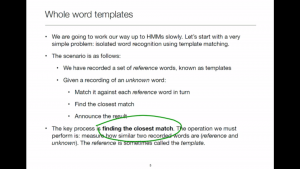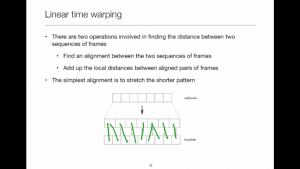Start with this very simple post, which reduces the problem to one of simply measuring distance in a feature space
then work through the videos and reading.

Whole word templates
Our first automatic speech recogniser stores an example ("template") of each word. Speech to be recognised is compared against each template.

Linear time warping
The simplest way to deal with variable duration is to stretch the unknown word to have the same duration as the template.
Reading
Holmes & Holmes – Chapter 8 – Template matching and dynamic time warping
Read up to the end of 8.5 carefully. Try to read 8.6 as part of Module 7, but rest assured we will go over the concept of dynamic programming again in Module 9. We recommend you should skim 8.7 and 8.8 because the same general concepts carry forward into Hidden Markov Models (again, we'll come back to this in Module 9). You don't need to read 8.9 onwards. Methods like DTW are rarely used now in state of the art systems, but are a good way to start understanding some core ideas.
Jurafsky & Martin – Chapter 9 introduction
The difficulty of ASR depends on factors including vocabulary size, within- and across-speaker variability (including speaking style), and channel and environmental noise.
Jurafsky & Martin – Section 9.1 – Speech Recognition Architecture
Most modern methods of ASR can be described as a combination of two models: the acoustic model, and the language model. They are combined simply by multiplying probabilities.
Jurafsky & Martin – Section 9.3 – Feature Extraction: MFCCs
Mel-frequency Cepstral Co-efficients are a widely-used feature with HMM acoustic models. They are a classic example of feature engineering: manipulating the extracted features to suit the properties and limitations of the statistical model.
The following exercise involves programming in Python, and so is beyond the scope of this course. If you can program, then you may find this quite helpful in developing your understanding of dynamic programming.




